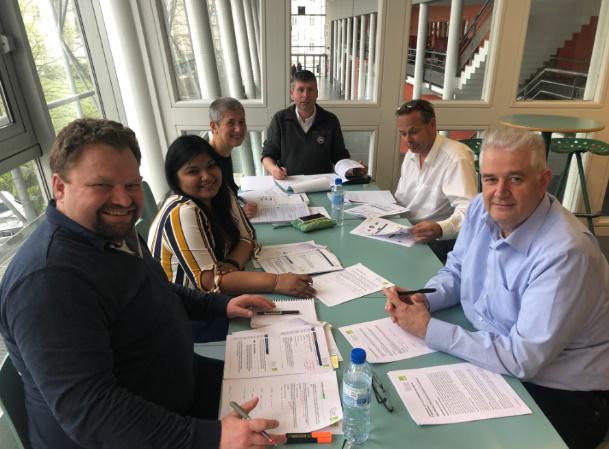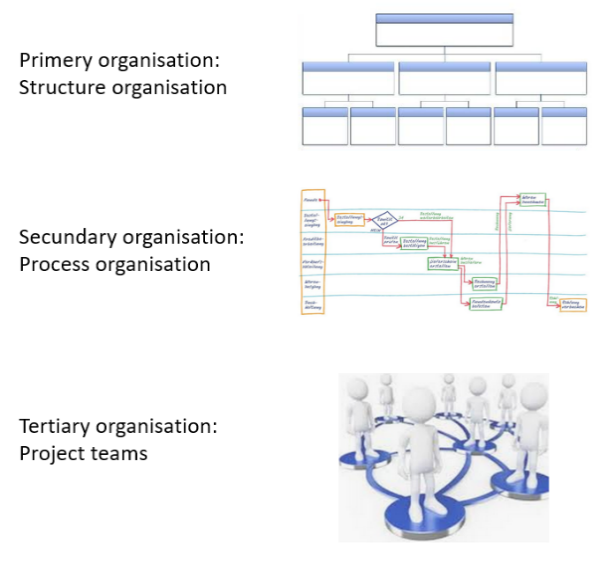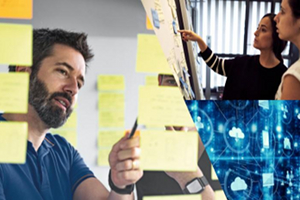MIPLM 2018-19: 4th module on IP in agile innovation management
The 4th module of MIPLM program is about organization. Structure is key to implement strategies. Companies look for the structure-strategy-fit, which means, that their organization fits with their respective strategic objectives. Within the digital transformation it is a challenge for traditional companies to find appropriate organizational structures and processes for new business models. In addition, digitalization also demands a different innovation and IP management.
 Traditionally there are three different forms of organization distinguished: Structural, process and project organization. Structural organization describes the hierarchical and functional structure of a company. It is a static system to assign competencies and responsibilities to organizational entities like departments. Process structure represents the way how tasks are fulfilled within the necessary working steps. Structure and process organization represents a thinking style in constant and repeating activities and business transactions. Project management differs basically from this kind of thinking. A project has certain characteristic features: It is unique, it has clear objectives, it is timely limited, it is financially limited, it has dedicated and specific staff, it is separated from other ventures within the organization, it has its own organization and typically it is something new and to a certain extend something innovative.
Traditionally there are three different forms of organization distinguished: Structural, process and project organization. Structural organization describes the hierarchical and functional structure of a company. It is a static system to assign competencies and responsibilities to organizational entities like departments. Process structure represents the way how tasks are fulfilled within the necessary working steps. Structure and process organization represents a thinking style in constant and repeating activities and business transactions. Project management differs basically from this kind of thinking. A project has certain characteristic features: It is unique, it has clear objectives, it is timely limited, it is financially limited, it has dedicated and specific staff, it is separated from other ventures within the organization, it has its own organization and typically it is something new and to a certain extend something innovative.
 Companies use project management to work on extraordinary tasks and challenges like innovation and business development. Project teams are a kind of third layer upon structural and process organization. Project organization is a special case of organization because it only exits for the limited time the project exists. Members of the project teams are responsible for the project and at the same time they are anchored within the primary and secondary organization.
Companies use project management to work on extraordinary tasks and challenges like innovation and business development. Project teams are a kind of third layer upon structural and process organization. Project organization is a special case of organization because it only exits for the limited time the project exists. Members of the project teams are responsible for the project and at the same time they are anchored within the primary and secondary organization.
The classical or traditional way of project management is described by the waterfall concept. Waterfall project management is a sequential, linear process. It consists of several discrete phases. No phase begins until the prior phase is complete, and each phase’s completion is terminal. Waterfall management does per definition not allow to return to a previous phase. Along with the waterfall concept some issues are observed which are growing with the complexity of the project.
- One area which almost always falls short is the effectiveness of requirements. Gathering and documenting requirements in a way that is meaningful to a customer is often the most difficult part of development. Customers are sometimes intimidated by details, and specific details, which are provided early in the project, are required with this approach. In addition, customers are not always able to visualize an application from a requirements document.
- Another typical drawback of pure waterfall development is the possibility that the customer will be dissatisfied with their delivered product. As all deliverables are based upon documented requirements, a customer may not see what will be delivered until it’s almost finished. By that time, changes can be difficult (and costly) to implement.
In contrast, agile project management is a specific type of rapid product development. Agile is an iterative, team-based approach to development. This approach emphasizes the rapid delivery of a product in reasonable functional components. Rather than creating tasks and fixed schedules, time is “time-boxed” into phases called “sprints.” Each sprint has a defined duration (usually in weeks) with a running list of deliverables, planned at the start of the sprint. Deliverables are prioritized by business value as determined by the customer. If all planned work for the sprint cannot be completed, work is reprioritized and the information is used for future sprint planning.
As work is completed, it can be reviewed and evaluated by the project team and customer, through daily builds and end-of-sprint demos. Agile management relies on a very high level of customer involvement throughout the project, but especially during these reviews. Some advantages of the agile approach are easy to see:
- The customer has frequent and early opportunities to see the work being delivered, and to make decisions and changes throughout the development project.
- The customer gains a strong sense of ownership by working extensively and directly with the project team throughout the project.
- If time to market for a specific application is a greater concern than releasing a full feature set at initial launch, agile management can more quickly produce a basic version of working software which can be built upon in successive iterations.
- Development is often more user-focused, likely a result of more frequent interaction with the customer.
Here is a short introduction to agile project management:
In addition, the 4th MIPLM module gives an introduction into organizational economics, which is the economic analysis and design of organizations. Organizational economics is primarily concerned with the obstacles to coordinate the activities inside and between organizational entities like firms, alliances, institutions and the market. Organizational economics can be divided into three lines of argumentations:
- Transaction cost theory: costs incurred to organize an activity, especially regarding research of information, bureaucracy, communication etc.
- Agency theory: dilemmas connected to making decisions on behalf of or impacting another person or entity.
- Contract theory: ways economic actors use to construct contractual arrangements, generally in the presence of asymmetric information.
Complementary, the 4th MIPLM module discusses also institutional economics. This perspective attempts to extend economics by focusing on social and legal norms and rules, which are called institutions. The concepts of institutional economics are used to analyze organizational arrangements like property rights, transaction costs, enforcement mechanisms, monitoring costs and bargaining strength. With these powerful tools in hand, students can analyze the quality of the fit between strategic objectives and the organizational implementation of a strategy.
Case study presentations:
Task 1:
Implementation of a Differentiation Center
Please outline the business model behind the Smart Tooth. For this purpose, please distinguish the resource perspective and the market perspective of the business model. Please describe the differences in the framework of typical business models of traditional pharma companies and digital business models. Please derive the typical generic IP strategy for traditional business models of the pharma industry as well as for digital business models from the framework described above. Please assign the two business models / generic IP-strategies to the organizational structure that is best suited for their implementation. Please indicate the three processes in which core aspects differ in a differentiation center and a protection center.
Here you can follow the presentation to task 1:
Presented by:
- Rabia Nurgul Ozbaylanli, Turkish Patent and Trademark Office, Ankara, Turkey
- Frederic Sahores, STMicroelectronics SA, Crolles, France
- Katsuya Iwazaki, Toyota Motor Corporation Ltd., Aichi, Japan
- Christiane Marti, Novartis Pharma AG, Basel, Switzerland
- Andreas Weiland, Maschinenfabrik Rieter AG, Winterthur, Switzerland
- James Eilertsen, Heptagon OY, Rueschlikon/Zurich, Switzerland
- Martin Salzburger, Airbus Defence and Space GmbH, Manching, Germany
Task 2:
FtO and the Differentiation Center
Please describe the technical structure of the typical products and services in traditional and digital business models (for this purpose please show the system components of the Smart Tooth business model). Refer to the system boundaries in both cases. Patent types describe a class of established problem-solution combinations in the patent literature that relate to an aspect of a business model or business model realization which is worth IP-protection. Please assign these patent types to the system descriptions presented above. Based on these patent types, please estimate the search-related conditions for the associated system components. In your opinion which effect does this have on the search procedure? Please describe a possible FtO-process for a traditional pharma business model in a protection center. Please describe a possible FtO-process for a digital pharma business model in a differentiation center. Identify the differences to the FtO-process in the protection center and justify them. Please illustrate differences in the timeline of the development processes and derive the implications for the performance of the FtO analysis.
Here you can follow the presentation to task 2:
Presented by:
- Isabella Ferri, Solvay SA, Bollate, Italy
- Roland Bittner, Siemens AG, Erlangen, Germany
- Neha Goel, Eaton India Innovation Center, Pune, India
- Michael Kirklies, KIPAT Patentanwälte, Neu-Ulm, Germany
- Kamran Houshang Pour Islam, IPI, Bern, Switzerland
- Hendrik Promies, Siemens AG, Erlangen, Germany
Task 3:
Institutional Economics and the implementation of a Differentiation Center
Please explain the principle of a taxonomy and why this tool should be used within a differentiation center. Then analyze the application of a taxonomy from an institutional economics perspective. Please consider the property rights theory. Please explain how the competitive environment may be monitored within a differentiation center. Please analyze the benefits of such a monitoring system from an institutional economics perspective. Particularly consider the agency theory and the property rights theory in your analysis. Please explain how the portfolio management should be designed in a differentiation center. Analyze the benefits of a comprehensive portfolio management from an institutional economics perspective. Please consider the agency theory. Please explain the principle of synthetic inventing and why it is useful in a differentiation center. Then analyze the application of synthetic inventing from an institutional economics perspective. Please consider the property rights theory and the transaction costs. Please explain how IP management should be linked to the technology roadmap process within a differentiation center. Then analyze from an institutional economics perspective why such a procedure is making sense. Please consider the property rights theory.
Please explain why synthetic inventing should be accompanied by employee invention remuneration in a differentiation center. Then analyze the typical situation from an institutional economics perspective. Please consider the agency theory and the transaction costs.
Here you can follow the presentation to task 3:
Presented by:
- Giulia Ubertone, Self-employed lawyer, Monza, Italy
- Charles Roger, France Brevets SAS, Paris, France
- Plamena Giorgieva, EUIPO, Alicante, Spain
- Björn Möller, Siemens AG, Munich, Germany
- Idoia Apraiz, Galbaian, Mondragon, Spain
- Vincent Chevroton, Faurecia Innenraum Systeme GmbH, Hagenbach, Germany



